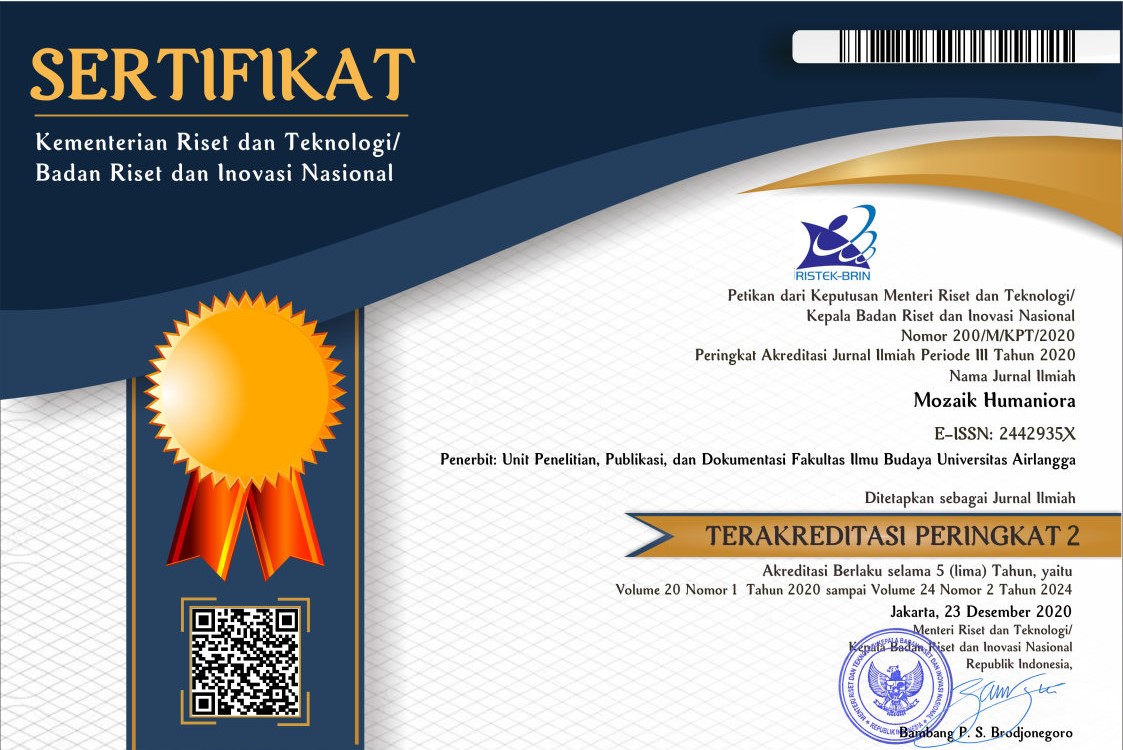Translation Strategies of Nusantara Food Menu
Downloads
The research aims to analyze the translation strategies and the use of Culture-Specific Items (CSIs) in nusantara food menus in Indonesia. Translators usually use their perception to translate the menu without the involvement of the chefs. As a result, the translation of food menus can vary from one restaurant to another because each chef has their unique way of preparing their food. Collaboration between translators and chefs is necessary to ensure that the translated menus highlight the characteristics and uniqueness of each dish. The results show that the translation strategies used are Reduction and Expansion (81 data), Couplets (34 data), Cultural Equivalence (8 data), Transference (7 data), Descriptive Equivalence (5 data), Functional Equivalence (4 data), and Naturalization (2 data). The use of CSIs found in the data are Ingredients (186 data), Cooking Techniques (113 data), Seasoning (83 data), Proper Name (39 data), Flavor (9 data), Color (7 data), and Texture (4 data). However, the translation strategy of Synonymy, Through-Translation, Shift or Transposition, Modulation, Recognised Translation, Translation Label, Compensation, Componential Analysis, Paraphrase, and Other Procedures are not found in the data.
Aixelá, J. F. 1996. “Culture-Specific Items in Translation.” In Translation, Power, Subversion, edited by R. Alvarez & M.C.-A. Vidal. Multilingual Matters. DOI: 10.21832/9781800417915-005.
Amenador, K. B. & Z. Wang. 2022. “The Translation of Culture-Specific Items (CSIs) in Chinese-English Food Menu Corpus: A Study of Strategies and Factors.” Sage Open 12 (2). DOI: 10.1177/21582440221096649.
Badan Pengembangan dan Pembinaan Bahasa. 2023. KBBI VI Daring, kbbi.kemdikbud.go.id.
Cheng, L., K. K. Sin, & A. Wagner (eds.). 2014. The Ashgate Handbook of Legal Translation. Surrey: Ashgate.
Ciolăneanu, R. & P. Nanu. 2018. Translation and Cultural Mediation: Inside and Outside, Perspectives on Romanian Language, Culture and Literature. Turku: University of Turku.
Edmonds, I., A. S. Petrc, & K. Mikinac. 2019. “Strategic Approaches to Menu Translation Analysis.” Tourism in Southern and Eastern Europe: Creating Innovate Tourism Experiences. 10.20867/tosee.05.31.
Feng, Z. 2008. “Culture-Specific Items (CSIs) in Menu Translation.” Translation Studies: Current Trends and Future Perspectives, 123–145.
Fitriana, Y. A. N., N. H. Sigit, S. Alfiyati, A. N. Mufidah, N. Furayda, & I. Fajriyati. 2020. “Analisis Produk dan Inovasi Pangan: Bumbu Racik Nasi Goreng Kedelai Hitam (Buked Hitam).” SAINTEKS 17 (2), 173–186.
Ghafarian, M., R. Kafipour, & A. Soori. 2016. “Domestication and Foreignisation Strategies in Restaurant Menu Translation.” Pertanika 24 (4), 1417—1429.
Li, S. 2018. A Corpus-Based Multimodal Approach to the Translation of Restaurant Menus. Perspectives 27 (1), 1—19. DOI: 10.1080/0907676X.2018.1483408.
Newmark, P. 1988. A Textbook of Translation. Prentice HaH International vUIO Ltd.
Rosadi, A. 2023. “Resep Mie Godog Jawa, Pedas Gurihnya Bikin Hangat Badan.” Idntimes.com, https://www.idntimes.com/food/recipe/amir-rosadi/resep-mie-godog-jawa-c1c2-1, 4 January.
Sudaryanto. 1993. Metode dan Aneka Teknik Analisis Bahasa: Pengantar Penelitian Wahana Kebudayaan Secara Linguistis. Yogyakarta: Duta Wacana University Press.
Tanudirjo, K. R2020. “The English Translation of Food Menu in Three Restaurants in Yogyakarta: The Acceptability and The Strategies.” Bachelor Thesis. Yogyakarta: Universitas Sanata Dharma.
TasteAtlas Team. 2023. “Rawon.” Tasteatlas.com.
Yingmin, T. & N. L. N. S. Malini. 2021. “Translation Strategies Applied in Culinary Culture-Specific Items.” The International Journal of Language and Cultural 3 (2), 18—28. https://www.growingscholar.org/journal/index.php/TIJOLAC/article/view/128.
Copyright (c) 2024 Agus Darma Yoga Pratama, Dewa Ayu Dyah Pertiwi Putri

This work is licensed under a Creative Commons Attribution-ShareAlike 4.0 International License.

Mozaik Humaniora is licensed under a Creative Commons Attribution-ShareAlike 4.0 International License. Both authors and Mozaik Humaniora agree with the following attribution of journal:
1. Copyright of this journal is possession of Author, by the knowledge of the Editorial Board and Journal Manager, while the moral right of the publication belongs to the author.
2. The journal allows the author(s) to retain publishing rights without restrictions
3. The legal formal aspect of journal publication accessibility refers to Creative Commons Attribution Share-Alike (CC BY-SA).
4. The Creative Commons Attribution Share-Alike (CC BY-SA) license allows re-distribution and re-use of a licensed work on the conditions that the creator is appropriately credited and that any derivative work is made available under "the same, similar or a compatible license”. Other than the conditions mentioned above, the editorial board is not responsible for copyright violation.


















